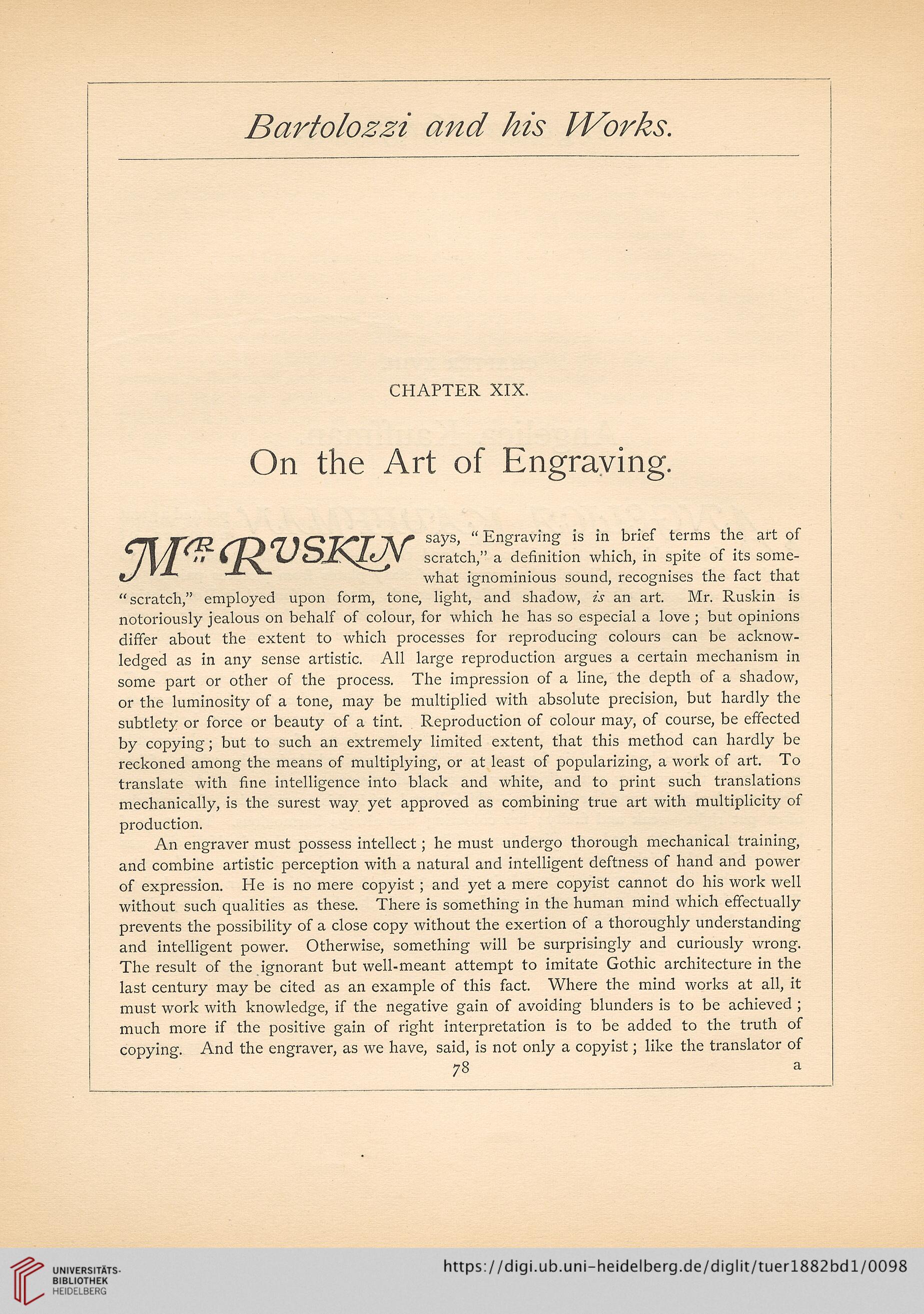Barto/o^i and his Works.
CHAPTER XIX.
On the Art of Engraving.
CM T/R /T) 1 ) QTC'T A/" sa's' "Engraving is in brief terms the art of
6 Ut>T\Lc/ Y scratch," a definition which, in spite of its some-
what ignominious sound, recognises the fact that
"scratch," employed upon form, tone, light, and shadow, is an art. Mr. Ruskin is
notoriously jealous on behalf of colour, for which he has so especial a love ; but opinions
differ about the extent to which processes for reproducing colours can be acknow-
ledged as in any sense artistic. All large reproduction argues a certain mechanism in
some part or other of the process. The impression of a line, the depth of a shadow,
or the luminosity of a tone, may be multiplied with absolute precision, but hardly the
subtlety or force or beauty of a tint. Reproduction of colour may, of course, be effected
by copying; but to such an extremely limited extent, that this method can hardly be
reckoned among the means of multiplying, or at least of popularizing, a work of art. To
translate with fine intelligence into black and white, and to print such translations
mechanically, is the surest way yet approved as combining true art with multiplicity of
production.
An engraver must possess intellect ; he must undergo thorough mechanical training,
and combine artistic perception with a natural and intelligent deftness of hand and power
of expression. He is no mere copyist ; and yet a mere copyist cannot do his work well
without such qualities as these. There is something in the human mind which effectually
prevents the possibility of a close copy without the exertion of a thoroughly understanding
and intelligent power. Otherwise, something will be surprisingly and curiously wrong.
The result of the ignorant but well-meant attempt to imitate Gothic architecture in the
last century may be cited as an example of this fact. Where the mind works at all, it
must work with knowledge, if the negative gain of avoiding blunders is to be achieved ;
much more if the positive gain of right interpretation is to be added to the truth of
copying. And the engraver, as we have, said, is not only a copyist; like the translator of
78 a
CHAPTER XIX.
On the Art of Engraving.
CM T/R /T) 1 ) QTC'T A/" sa's' "Engraving is in brief terms the art of
6 Ut>T\Lc/ Y scratch," a definition which, in spite of its some-
what ignominious sound, recognises the fact that
"scratch," employed upon form, tone, light, and shadow, is an art. Mr. Ruskin is
notoriously jealous on behalf of colour, for which he has so especial a love ; but opinions
differ about the extent to which processes for reproducing colours can be acknow-
ledged as in any sense artistic. All large reproduction argues a certain mechanism in
some part or other of the process. The impression of a line, the depth of a shadow,
or the luminosity of a tone, may be multiplied with absolute precision, but hardly the
subtlety or force or beauty of a tint. Reproduction of colour may, of course, be effected
by copying; but to such an extremely limited extent, that this method can hardly be
reckoned among the means of multiplying, or at least of popularizing, a work of art. To
translate with fine intelligence into black and white, and to print such translations
mechanically, is the surest way yet approved as combining true art with multiplicity of
production.
An engraver must possess intellect ; he must undergo thorough mechanical training,
and combine artistic perception with a natural and intelligent deftness of hand and power
of expression. He is no mere copyist ; and yet a mere copyist cannot do his work well
without such qualities as these. There is something in the human mind which effectually
prevents the possibility of a close copy without the exertion of a thoroughly understanding
and intelligent power. Otherwise, something will be surprisingly and curiously wrong.
The result of the ignorant but well-meant attempt to imitate Gothic architecture in the
last century may be cited as an example of this fact. Where the mind works at all, it
must work with knowledge, if the negative gain of avoiding blunders is to be achieved ;
much more if the positive gain of right interpretation is to be added to the truth of
copying. And the engraver, as we have, said, is not only a copyist; like the translator of
78 a




